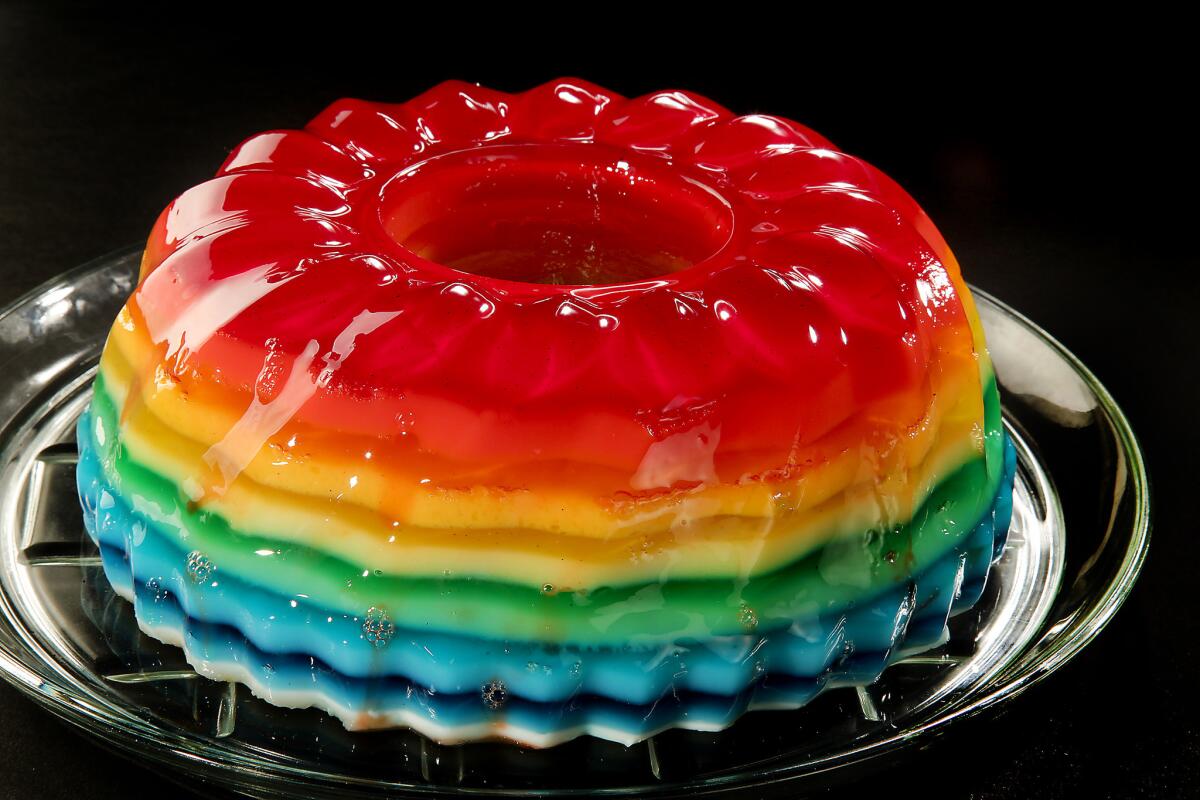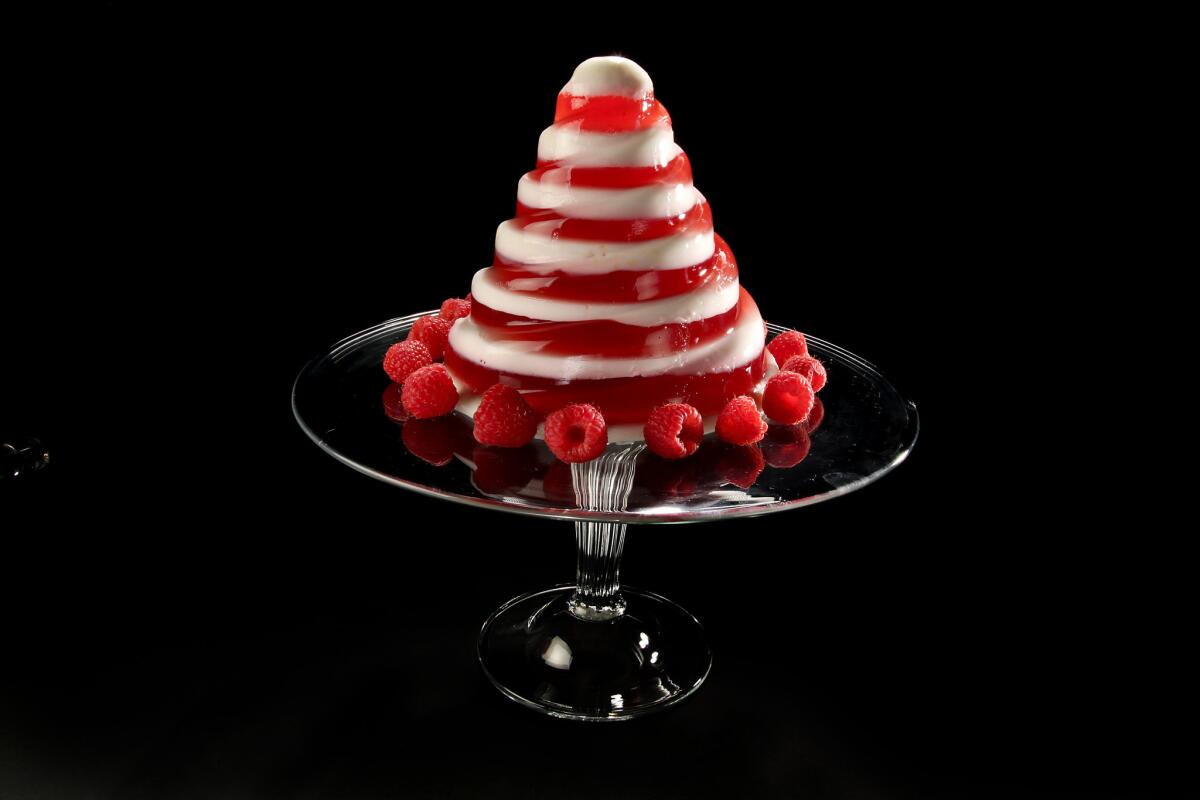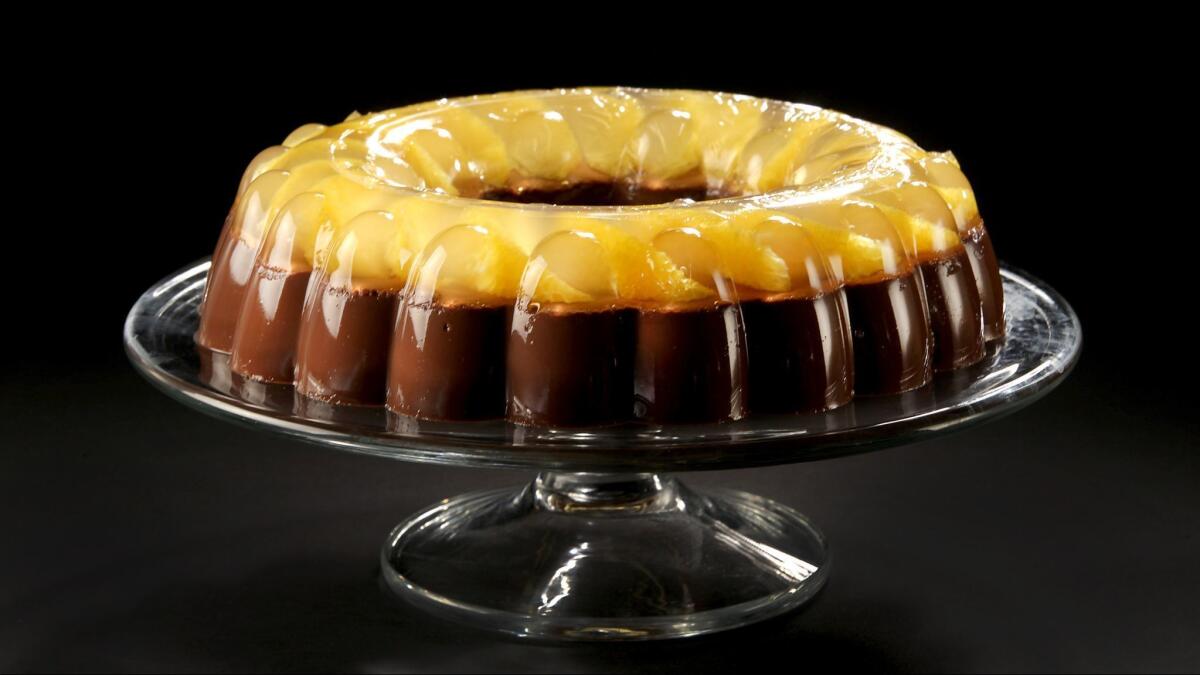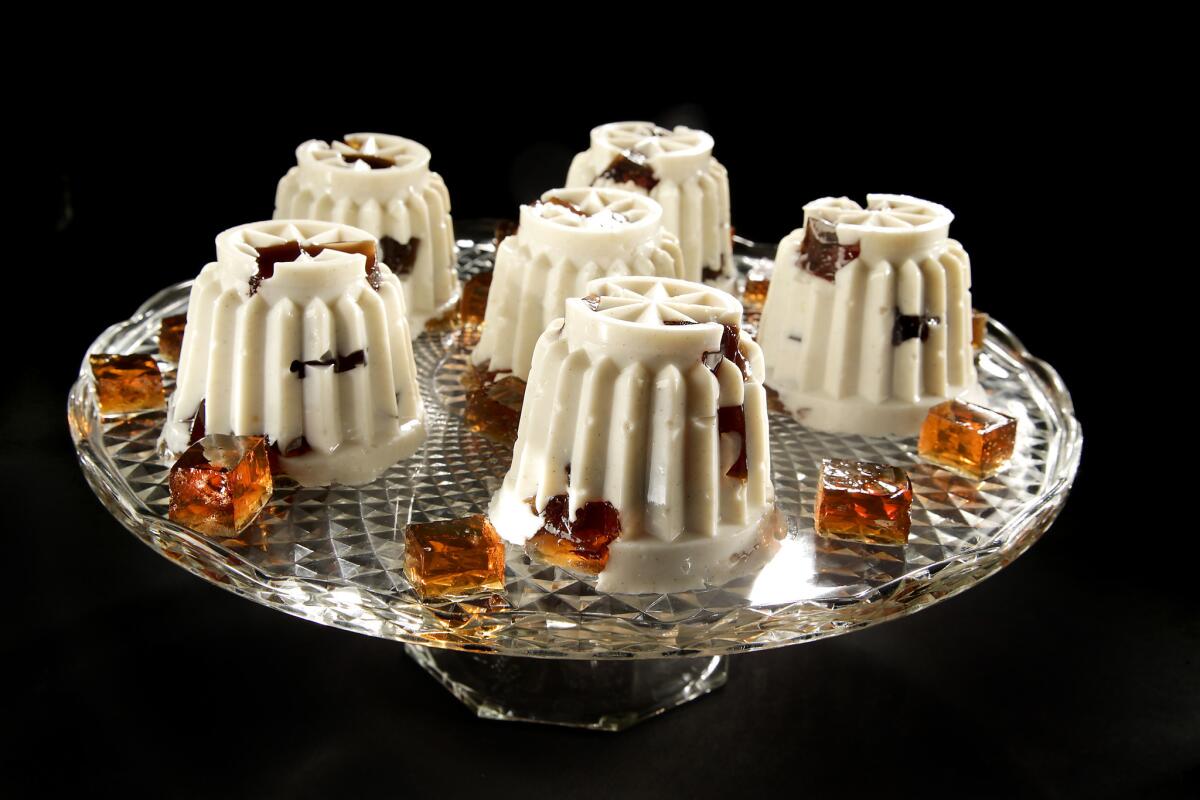Why you should be bringing Jell-O to your next party (alcohol and holograms optional)

The chef and owner of Father’s Office demos his latest creation: an interpretation of a mint julep inside a “bar of soap.”
- Share via
Standing in his Culver City test kitchen, chef Sang Yoon is holding what looks like a freshly used bar of soap, in a soap dish.
“So, it’s basically a Jell-O shot,” says Yoon of the dish, barely suppressing a laugh. “It’s an interpretation of a mint julep buried inside a bar of soap,” continues the chef, who is behind the lauded restaurants Father’s Office and Lukshon.
As his pastry chef Megan Potthoff slices the bar in two, the dish begins to materialize: Bourbon-flavored gelatin with crème de menthe-infused tapioca pearls tucked into silky mint-flavored mousse and set in a soap mold, surrounded by sweetened mint tea “lather” — what may be the fanciest, most unexpected gelatin dessert in the city.
Yoon, whose Lukshon is currently No. 4 on Jonathan Gold’s 101 Best Restaurants List, may be the last person you’d expect to consider putting gelatin on his menu. But the chef is intently philosophical when it comes to food and challenging expectations. “In the end we want you to say, ‘Oh wow, this tastes like a mint julep.’ But rather than go the direct route, we want to take you on a little ride.”
When was the last time you had fun with Jell-O or gelatin dishes? Once a wildly colorful rite of childhood, gelatin all-too-often gets a bad rap as we transition to adulthood. Once the stuff of cafeteria lunches and pool parties, we now associate it more with hospital food.

“Jell-O needed a makeover,” writes Victoria Belanger in the introduction to her book “Hello, Jell-O!”
Belanger, the self-styled “Jell-O Mold Mistress of Brooklyn,” is a fan of the stuff. “I started doing Jell-O molds back in 2008,” she says. “It was for a party. It’s the first time that something I had taken received so much attention.” Where cookies and pies are common dessert table fare, gelatin molds get noticed, she stresses — even more so if they contain alcohol.
“I think it’s a throwback to simpler times,” says Belanger. “It’s simple, easy and cheap, and you don’t have to be a master chef.”

Recipe: Raspberry ribband gelatin »
Professionally trained as a photographer, Belanger continued making Jell-O molds for parties and gatherings, looking up old cookbooks for inspiration, but adding a modern twist, such as floating root beer gelatin cubes in ice cream gelatin for a take on the root beer float. The hobby soon spun off into a blog and the book. “People are surprised by my molds,” she says. “When they think Jell-O, they think of what they had for lunch in school. And then they taste mine and it’s all these crazy flavors and way better than what they expected.”
“Nothing makes people smile like wobbly jelly,” says Sam Bompas. He and his business partner, Harry Parr, run a London-based studio, Bompas & Parr, focused on multi-sensory experience design. They founded the British Museum of Food and have had a number of projects and books exploring humanity’s relationship to food.

Recipe: Orange chocolate mold »
The duo, who call themselves Jelly-Mongers, have been making what the British colloquially call “jellies” and using custom 3-D-printed molds for more than a decade. One of their first major projects was the Architectural Jelly Design Competition held at University College London to illustrate the link between gelatin and architecture, with over 100 designs submitted and drawing some of the biggest names in architecture (including Lord Foster, who designed a “jelly” in homage to his “wobbly” London Millenium Bridge). Over the years, the pair have created thousands of “jellies” for events, parties, television and online, some weighing in at 50 tons.
“We started making jellies because we wanted something fun to do — fun is really a crucial word,” says Bompas. “There’s so much you can do, and it has such an incredible history.”
Gelatin and similar jelling agents have been in use for thousands of years, and throughout most of history molded dishes were the provenance of royalty and the well-to-do given the labor involved and sheer expense of ingredients and molds.

Recipe: Root beer float squares »
Powdered gelatin was first patented in 1845 and the Jell-O brand was introduced in 1897, and soon, jelled dishes went mainstream due to a congregation of elements: mass-production of gelatin, modern refrigeration, plastic and other inexpensive molds, packaging and marketing. By the 1950s Jell-O was considered everything from the food of the future to a health food, complete with its own diet. And who can forget all those wild colors.
“If you think about it, the 20th century was really the ‘Dark Ages’ for jelly,” says Bompas.
Belanger argues that it’s that “kitsch” factor she’s trying to move beyond with her molds. “People have expectations when they see Jell-O molds,” she says. “As I got more advanced, I started using plain gelatin and juice instead of pre-flavored boxes. I’m doing fruit juice and ice cream — sweetened condensed milk is a staple in a lot of my recipes.”
“Anything you can turn into a juice — which is everything — can become a jelly,” says Bompas. “It can be fun and childish, but if it’s recontextualized in fine dining restaurants or in an art gallery, people will see it with fresh eyes.”
Henry Hargreaves is an artist and photographer from New Zealand who frequently uses food as a medium, and has been exhibited in Bompas & Parr’s Museum of Food. He’s done a couple of gelatin-based projects, including a series of portraits of U.S. presidents made from colored gelatin, as well as “Jello Submarine,” a vivid homage to the Beatles made out of edible gelatin. “I did the presidents series in the lead up to the 2012 election,” he says. “I wanted to do them in something that to me was just a very American food.”

Recipe: Blueberry gin and tonic gelatin »
“I’ve always enjoyed playing with people’s expectations when it comes to food,” he says about his art. “I like to use food as a common denominator between the subject and viewer.”
For Yoon, food is about “disconnecting the visual from the payoff.” In professional kitchens, gelatin is used as a binder, a stabilizer — something that gives protein and structure to a dish. Customers often don’t know they’re eating gelatin. But in the case of the soap dish idea, “we wanted to show it, but not in a way you would immediately recognize, particularly with a mint julep. By being visually disruptive, you start to explore and the mind wanders.”
“If you look at jelly history apart from the 20th century, it’s always been high status and using cutting-edge technology,” says Bompas. He and Parr are doing their part to make sure that trend continues. In addition to using 3-D printers for some of the first food-related projects, the pair is also exploring other opportunities, including using molecular biology to come up with lab-grown alternatives to gelatin, as well as creating the first “holographic” gelatins. “We’re working on jellies which have a genuine hologram within them using complex molding and video techniques. It will be the world’s first holographic food.”
GELATIN TIPS AND TRICKS
Making your own “jellies” isn’t rocket science, but you do need to follow some rules.
- If you’ve never made a gelatin mold before, start small. Get a sense of how the gelatin works and feels before attempting complex designs such as layers or marbling.
- Plain gelatin comes in both powder and sheet form. Soften or “bloom” the gelatin in cool liquids, then dissolve it using hot liquids. If the gelatin does not completely dissolve, it may give your finished dish a gritty texture.
- To chill your prepared gelatin more quickly, stir it over an ice bath until it thickens before adding it to the mold. Never place the mold in the freezer.
- To determine the volume of your mold, fill it first with water to measure the number of cups.
- You can turn cups, bowls and baking and bundt pans into molds. Vintage molds can be found on websites such as EBay and Etsy, as well as at garage sales and thrift stores.
- Copper and aluminum molds conduct temperature much better than plastic or glass, and will chill or heat up more quickly.
- To unmold your gelatin, moisten your fingers and carefully loosen the edges of the gelatin from the mold. Dip the mold into warm water; timing will vary depending on the size and type of mold.
ALSO
Browse our California Cookbook recipe database for thousands of our best recipes
Recipes ready in 30 minutes or less
Get outdoors: Easy weeknight grilling recipes
More to Read
Eat your way across L.A.
Get our weekly Tasting Notes newsletter for reviews, news and more.
You may occasionally receive promotional content from the Los Angeles Times.











